HND Hospitality Unit 31: Food Safety Management Report and Analysis
VerifiedAdded on 2020/10/23
|15
|4023
|182
Report
AI Summary
This report delves into the critical aspects of food safety management within the hospitality industry. It begins with an introduction to food safety, highlighting the importance of preventing contamination and foodborne illnesses. The report then examines various controls for preventing physical and chemical contamination in food, comparing food poisoning and foodborne illnesses, and outlining methods for controlling them. Further sections categorize food spoilage agents, discuss food preservation methods, and evaluate their effectiveness. Temperature control systems, safe food storage, personal hygiene, cleaning, disinfection, and pest control are also addressed. The report covers risk assessment for food hazards, presents a food safety control system, and concludes with a guide for complying with food safety legislation, making it a comprehensive resource for understanding and implementing effective food safety practices in the hospitality environment.
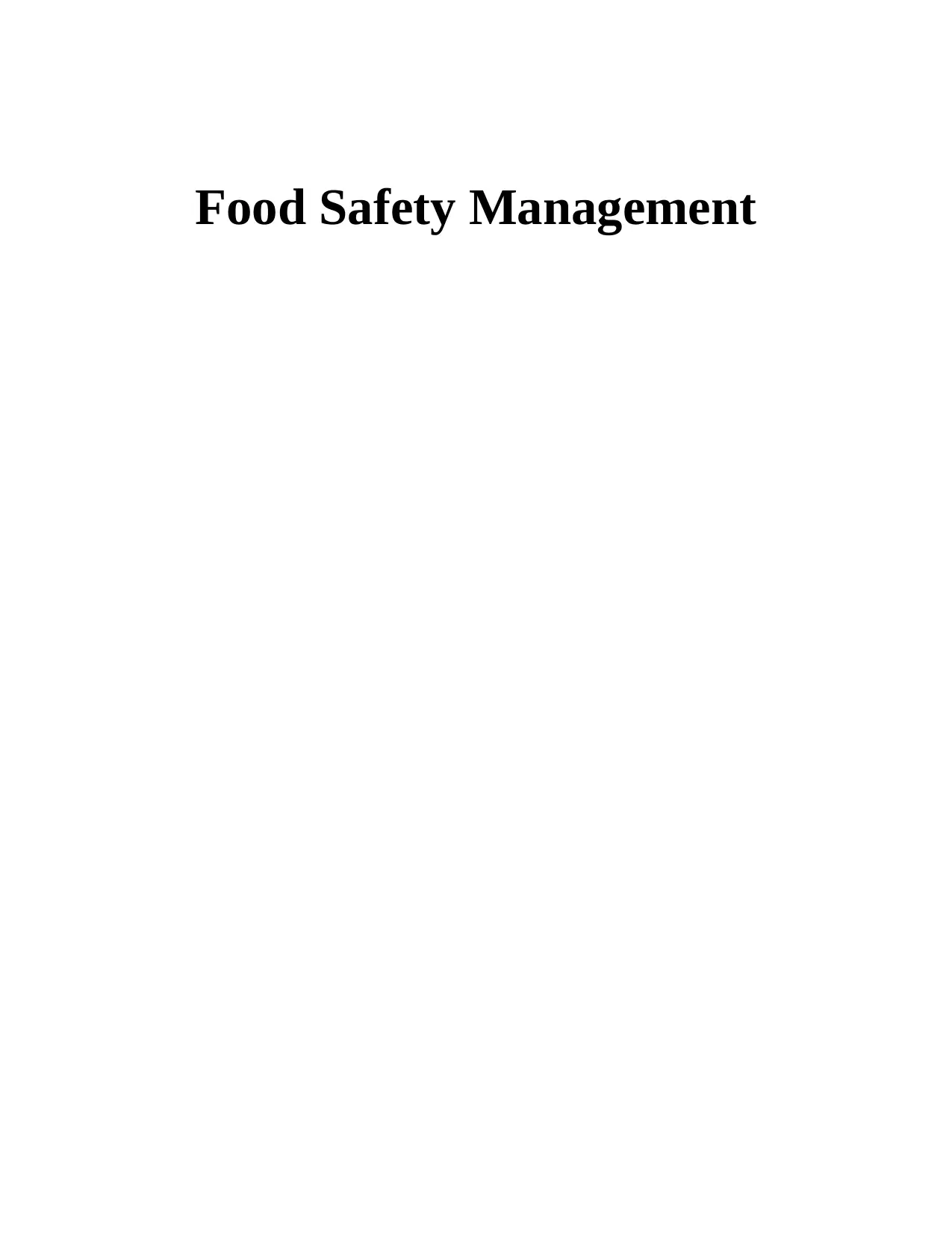
Food Safety Management
Paraphrase This Document
Need a fresh take? Get an instant paraphrase of this document with our AI Paraphraser
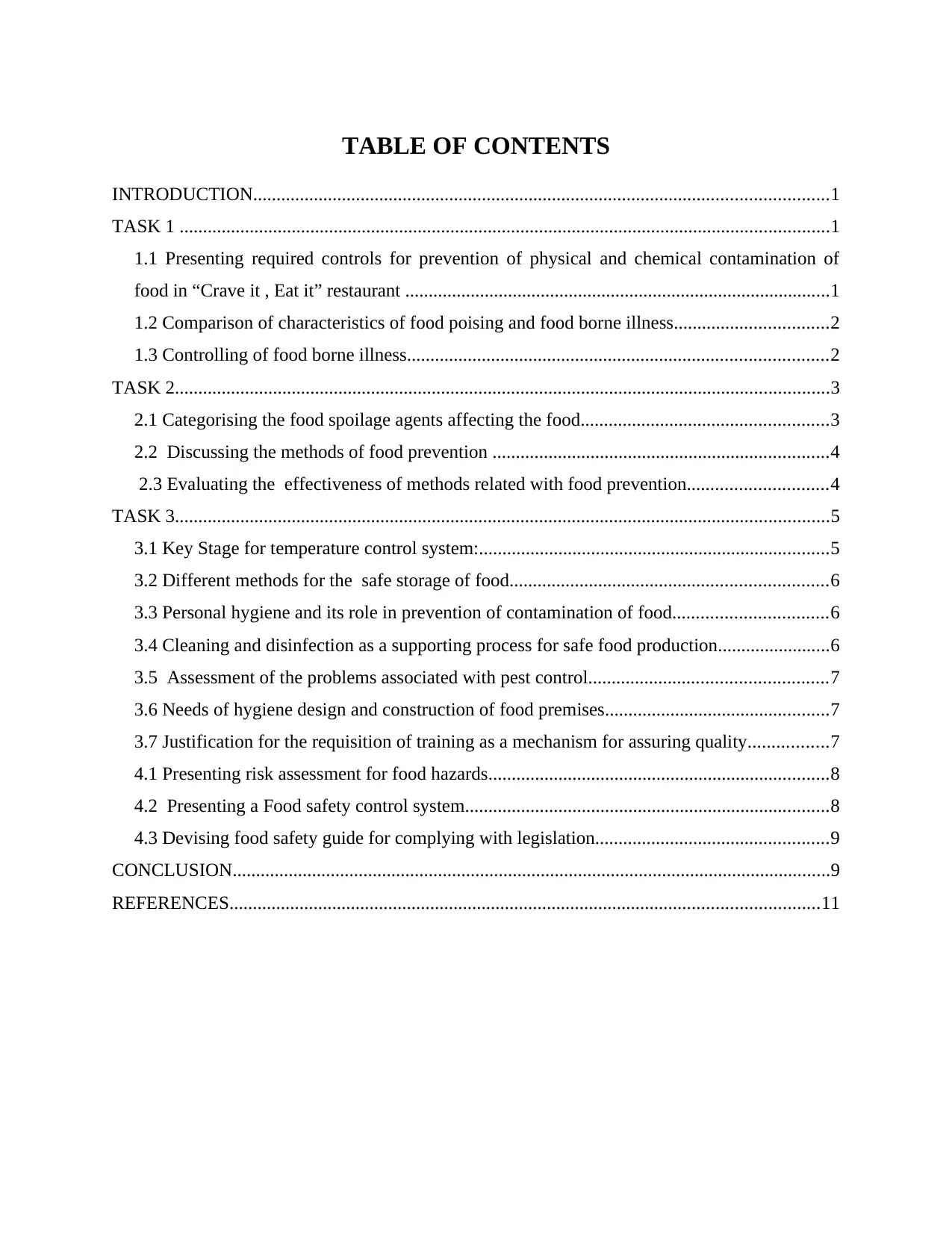
TABLE OF CONTENTS
INTRODUCTION...........................................................................................................................1
TASK 1 ...........................................................................................................................................1
1.1 Presenting required controls for prevention of physical and chemical contamination of
food in “Crave it , Eat it” restaurant ...........................................................................................1
1.2 Comparison of characteristics of food poising and food borne illness.................................2
1.3 Controlling of food borne illness..........................................................................................2
TASK 2............................................................................................................................................3
2.1 Categorising the food spoilage agents affecting the food.....................................................3
2.2 Discussing the methods of food prevention ........................................................................4
2.3 Evaluating the effectiveness of methods related with food prevention..............................4
TASK 3............................................................................................................................................5
3.1 Key Stage for temperature control system:...........................................................................5
3.2 Different methods for the safe storage of food....................................................................6
3.3 Personal hygiene and its role in prevention of contamination of food.................................6
3.4 Cleaning and disinfection as a supporting process for safe food production........................6
3.5 Assessment of the problems associated with pest control...................................................7
3.6 Needs of hygiene design and construction of food premises................................................7
3.7 Justification for the requisition of training as a mechanism for assuring quality.................7
4.1 Presenting risk assessment for food hazards.........................................................................8
4.2 Presenting a Food safety control system..............................................................................8
4.3 Devising food safety guide for complying with legislation..................................................9
CONCLUSION................................................................................................................................9
REFERENCES..............................................................................................................................11
INTRODUCTION...........................................................................................................................1
TASK 1 ...........................................................................................................................................1
1.1 Presenting required controls for prevention of physical and chemical contamination of
food in “Crave it , Eat it” restaurant ...........................................................................................1
1.2 Comparison of characteristics of food poising and food borne illness.................................2
1.3 Controlling of food borne illness..........................................................................................2
TASK 2............................................................................................................................................3
2.1 Categorising the food spoilage agents affecting the food.....................................................3
2.2 Discussing the methods of food prevention ........................................................................4
2.3 Evaluating the effectiveness of methods related with food prevention..............................4
TASK 3............................................................................................................................................5
3.1 Key Stage for temperature control system:...........................................................................5
3.2 Different methods for the safe storage of food....................................................................6
3.3 Personal hygiene and its role in prevention of contamination of food.................................6
3.4 Cleaning and disinfection as a supporting process for safe food production........................6
3.5 Assessment of the problems associated with pest control...................................................7
3.6 Needs of hygiene design and construction of food premises................................................7
3.7 Justification for the requisition of training as a mechanism for assuring quality.................7
4.1 Presenting risk assessment for food hazards.........................................................................8
4.2 Presenting a Food safety control system..............................................................................8
4.3 Devising food safety guide for complying with legislation..................................................9
CONCLUSION................................................................................................................................9
REFERENCES..............................................................................................................................11
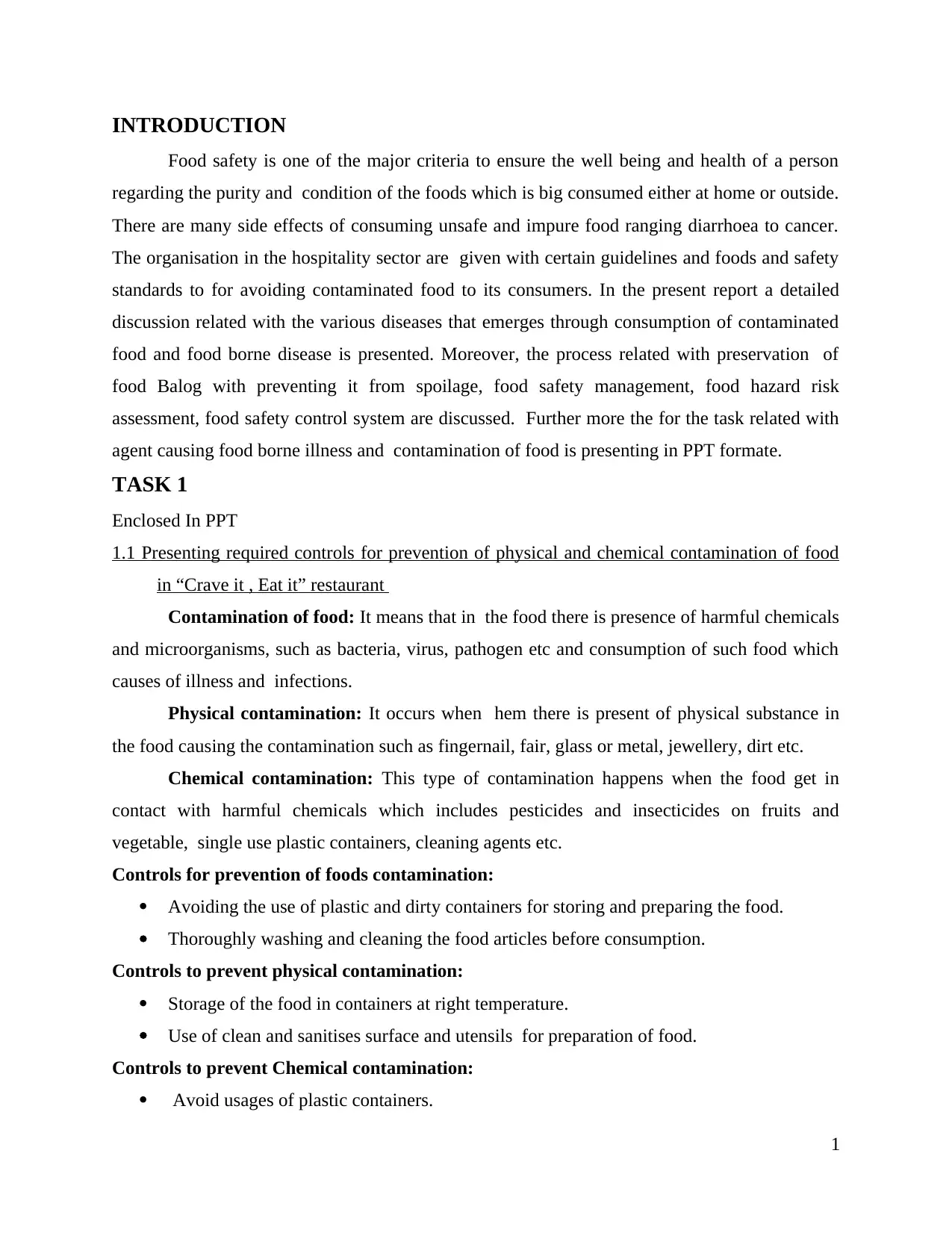
INTRODUCTION
Food safety is one of the major criteria to ensure the well being and health of a person
regarding the purity and condition of the foods which is big consumed either at home or outside.
There are many side effects of consuming unsafe and impure food ranging diarrhoea to cancer.
The organisation in the hospitality sector are given with certain guidelines and foods and safety
standards to for avoiding contaminated food to its consumers. In the present report a detailed
discussion related with the various diseases that emerges through consumption of contaminated
food and food borne disease is presented. Moreover, the process related with preservation of
food Balog with preventing it from spoilage, food safety management, food hazard risk
assessment, food safety control system are discussed. Further more the for the task related with
agent causing food borne illness and contamination of food is presenting in PPT formate.
TASK 1
Enclosed In PPT
1.1 Presenting required controls for prevention of physical and chemical contamination of food
in “Crave it , Eat it” restaurant
Contamination of food: It means that in the food there is presence of harmful chemicals
and microorganisms, such as bacteria, virus, pathogen etc and consumption of such food which
causes of illness and infections.
Physical contamination: It occurs when hem there is present of physical substance in
the food causing the contamination such as fingernail, fair, glass or metal, jewellery, dirt etc.
Chemical contamination: This type of contamination happens when the food get in
contact with harmful chemicals which includes pesticides and insecticides on fruits and
vegetable, single use plastic containers, cleaning agents etc.
Controls for prevention of foods contamination:
Avoiding the use of plastic and dirty containers for storing and preparing the food.
Thoroughly washing and cleaning the food articles before consumption.
Controls to prevent physical contamination:
Storage of the food in containers at right temperature.
Use of clean and sanitises surface and utensils for preparation of food.
Controls to prevent Chemical contamination:
Avoid usages of plastic containers.
1
Food safety is one of the major criteria to ensure the well being and health of a person
regarding the purity and condition of the foods which is big consumed either at home or outside.
There are many side effects of consuming unsafe and impure food ranging diarrhoea to cancer.
The organisation in the hospitality sector are given with certain guidelines and foods and safety
standards to for avoiding contaminated food to its consumers. In the present report a detailed
discussion related with the various diseases that emerges through consumption of contaminated
food and food borne disease is presented. Moreover, the process related with preservation of
food Balog with preventing it from spoilage, food safety management, food hazard risk
assessment, food safety control system are discussed. Further more the for the task related with
agent causing food borne illness and contamination of food is presenting in PPT formate.
TASK 1
Enclosed In PPT
1.1 Presenting required controls for prevention of physical and chemical contamination of food
in “Crave it , Eat it” restaurant
Contamination of food: It means that in the food there is presence of harmful chemicals
and microorganisms, such as bacteria, virus, pathogen etc and consumption of such food which
causes of illness and infections.
Physical contamination: It occurs when hem there is present of physical substance in
the food causing the contamination such as fingernail, fair, glass or metal, jewellery, dirt etc.
Chemical contamination: This type of contamination happens when the food get in
contact with harmful chemicals which includes pesticides and insecticides on fruits and
vegetable, single use plastic containers, cleaning agents etc.
Controls for prevention of foods contamination:
Avoiding the use of plastic and dirty containers for storing and preparing the food.
Thoroughly washing and cleaning the food articles before consumption.
Controls to prevent physical contamination:
Storage of the food in containers at right temperature.
Use of clean and sanitises surface and utensils for preparation of food.
Controls to prevent Chemical contamination:
Avoid usages of plastic containers.
1
⊘ This is a preview!⊘
Do you want full access?
Subscribe today to unlock all pages.

Trusted by 1+ million students worldwide
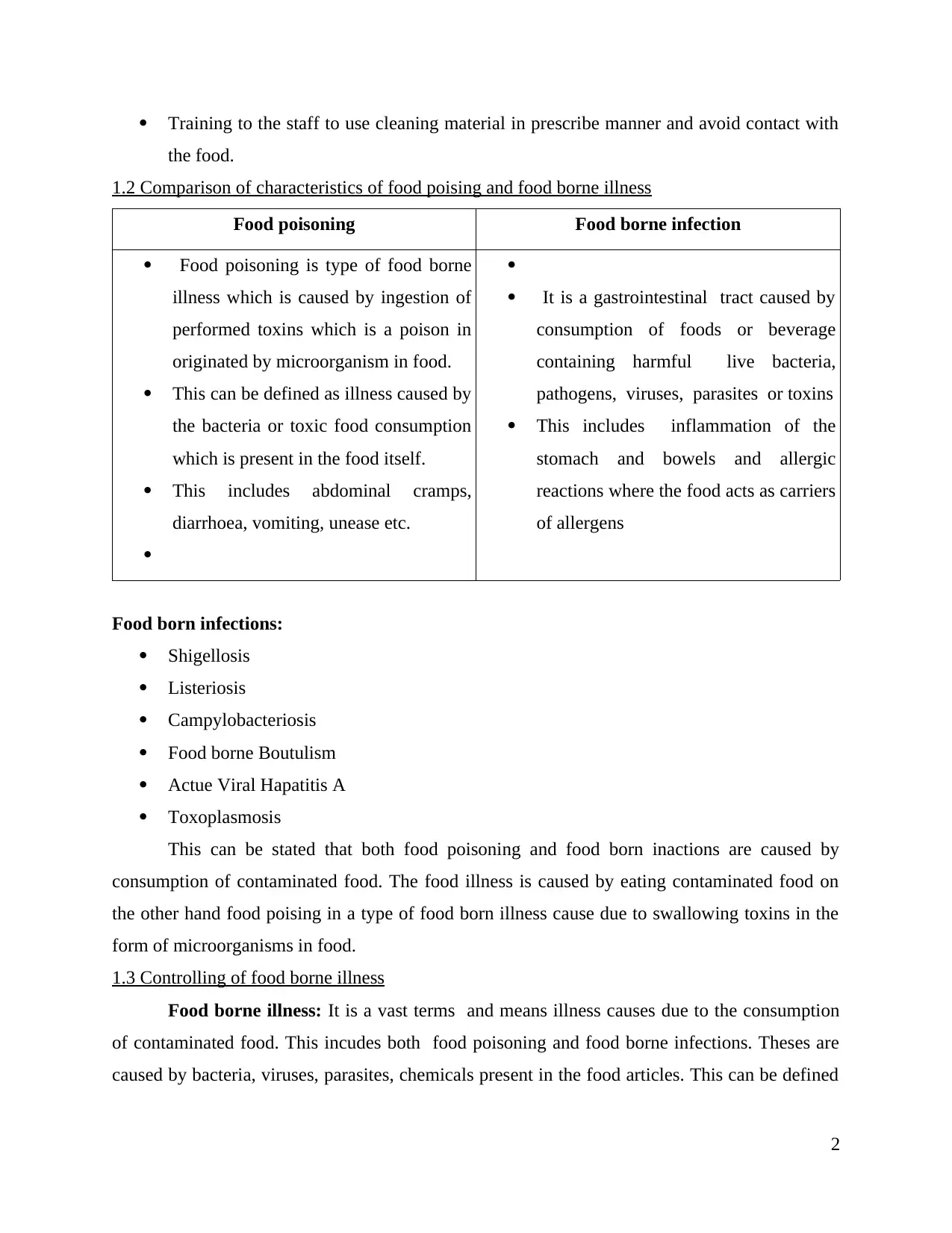
Training to the staff to use cleaning material in prescribe manner and avoid contact with
the food.
1.2 Comparison of characteristics of food poising and food borne illness
Food poisoning Food borne infection
Food poisoning is type of food borne
illness which is caused by ingestion of
performed toxins which is a poison in
originated by microorganism in food.
This can be defined as illness caused by
the bacteria or toxic food consumption
which is present in the food itself.
This includes abdominal cramps,
diarrhoea, vomiting, unease etc.
It is a gastrointestinal tract caused by
consumption of foods or beverage
containing harmful live bacteria,
pathogens, viruses, parasites or toxins
This includes inflammation of the
stomach and bowels and allergic
reactions where the food acts as carriers
of allergens
Food born infections:
Shigellosis
Listeriosis
Campylobacteriosis
Food borne Boutulism
Actue Viral Hapatitis A
Toxoplasmosis
This can be stated that both food poisoning and food born inactions are caused by
consumption of contaminated food. The food illness is caused by eating contaminated food on
the other hand food poising in a type of food born illness cause due to swallowing toxins in the
form of microorganisms in food.
1.3 Controlling of food borne illness
Food borne illness: It is a vast terms and means illness causes due to the consumption
of contaminated food. This incudes both food poisoning and food borne infections. Theses are
caused by bacteria, viruses, parasites, chemicals present in the food articles. This can be defined
2
the food.
1.2 Comparison of characteristics of food poising and food borne illness
Food poisoning Food borne infection
Food poisoning is type of food borne
illness which is caused by ingestion of
performed toxins which is a poison in
originated by microorganism in food.
This can be defined as illness caused by
the bacteria or toxic food consumption
which is present in the food itself.
This includes abdominal cramps,
diarrhoea, vomiting, unease etc.
It is a gastrointestinal tract caused by
consumption of foods or beverage
containing harmful live bacteria,
pathogens, viruses, parasites or toxins
This includes inflammation of the
stomach and bowels and allergic
reactions where the food acts as carriers
of allergens
Food born infections:
Shigellosis
Listeriosis
Campylobacteriosis
Food borne Boutulism
Actue Viral Hapatitis A
Toxoplasmosis
This can be stated that both food poisoning and food born inactions are caused by
consumption of contaminated food. The food illness is caused by eating contaminated food on
the other hand food poising in a type of food born illness cause due to swallowing toxins in the
form of microorganisms in food.
1.3 Controlling of food borne illness
Food borne illness: It is a vast terms and means illness causes due to the consumption
of contaminated food. This incudes both food poisoning and food borne infections. Theses are
caused by bacteria, viruses, parasites, chemicals present in the food articles. This can be defined
2
Paraphrase This Document
Need a fresh take? Get an instant paraphrase of this document with our AI Paraphraser
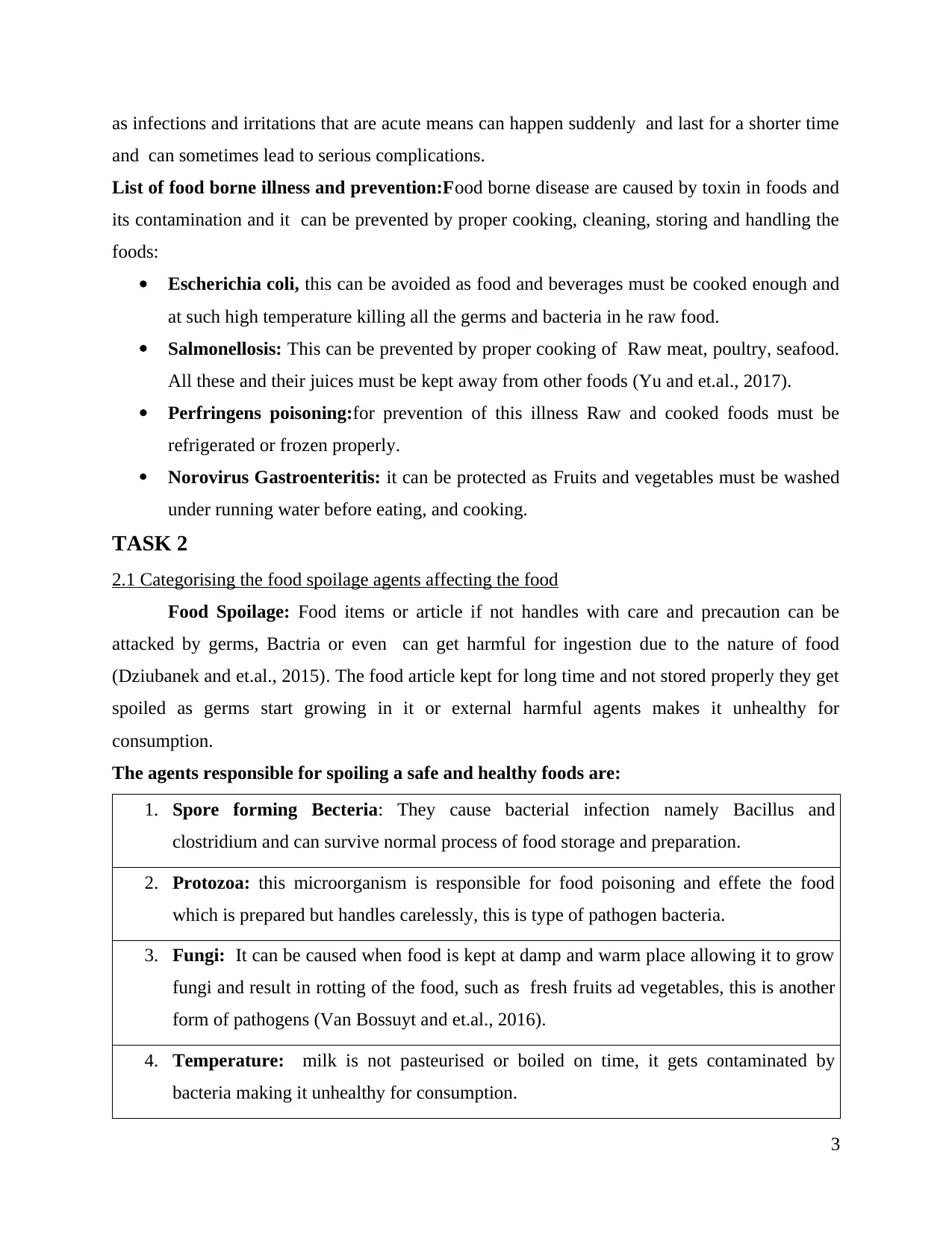
as infections and irritations that are acute means can happen suddenly and last for a shorter time
and can sometimes lead to serious complications.
List of food borne illness and prevention:Food borne disease are caused by toxin in foods and
its contamination and it can be prevented by proper cooking, cleaning, storing and handling the
foods:
Escherichia coli, this can be avoided as food and beverages must be cooked enough and
at such high temperature killing all the germs and bacteria in he raw food.
Salmonellosis: This can be prevented by proper cooking of Raw meat, poultry, seafood.
All these and their juices must be kept away from other foods (Yu and et.al., 2017).
Perfringens poisoning:for prevention of this illness Raw and cooked foods must be
refrigerated or frozen properly.
Norovirus Gastroenteritis: it can be protected as Fruits and vegetables must be washed
under running water before eating, and cooking.
TASK 2
2.1 Categorising the food spoilage agents affecting the food
Food Spoilage: Food items or article if not handles with care and precaution can be
attacked by germs, Bactria or even can get harmful for ingestion due to the nature of food
(Dziubanek and et.al., 2015). The food article kept for long time and not stored properly they get
spoiled as germs start growing in it or external harmful agents makes it unhealthy for
consumption.
The agents responsible for spoiling a safe and healthy foods are:
1. Spore forming Becteria: They cause bacterial infection namely Bacillus and
clostridium and can survive normal process of food storage and preparation.
2. Protozoa: this microorganism is responsible for food poisoning and effete the food
which is prepared but handles carelessly, this is type of pathogen bacteria.
3. Fungi: It can be caused when food is kept at damp and warm place allowing it to grow
fungi and result in rotting of the food, such as fresh fruits ad vegetables, this is another
form of pathogens (Van Bossuyt and et.al., 2016).
4. Temperature: milk is not pasteurised or boiled on time, it gets contaminated by
bacteria making it unhealthy for consumption.
3
and can sometimes lead to serious complications.
List of food borne illness and prevention:Food borne disease are caused by toxin in foods and
its contamination and it can be prevented by proper cooking, cleaning, storing and handling the
foods:
Escherichia coli, this can be avoided as food and beverages must be cooked enough and
at such high temperature killing all the germs and bacteria in he raw food.
Salmonellosis: This can be prevented by proper cooking of Raw meat, poultry, seafood.
All these and their juices must be kept away from other foods (Yu and et.al., 2017).
Perfringens poisoning:for prevention of this illness Raw and cooked foods must be
refrigerated or frozen properly.
Norovirus Gastroenteritis: it can be protected as Fruits and vegetables must be washed
under running water before eating, and cooking.
TASK 2
2.1 Categorising the food spoilage agents affecting the food
Food Spoilage: Food items or article if not handles with care and precaution can be
attacked by germs, Bactria or even can get harmful for ingestion due to the nature of food
(Dziubanek and et.al., 2015). The food article kept for long time and not stored properly they get
spoiled as germs start growing in it or external harmful agents makes it unhealthy for
consumption.
The agents responsible for spoiling a safe and healthy foods are:
1. Spore forming Becteria: They cause bacterial infection namely Bacillus and
clostridium and can survive normal process of food storage and preparation.
2. Protozoa: this microorganism is responsible for food poisoning and effete the food
which is prepared but handles carelessly, this is type of pathogen bacteria.
3. Fungi: It can be caused when food is kept at damp and warm place allowing it to grow
fungi and result in rotting of the food, such as fresh fruits ad vegetables, this is another
form of pathogens (Van Bossuyt and et.al., 2016).
4. Temperature: milk is not pasteurised or boiled on time, it gets contaminated by
bacteria making it unhealthy for consumption.
3
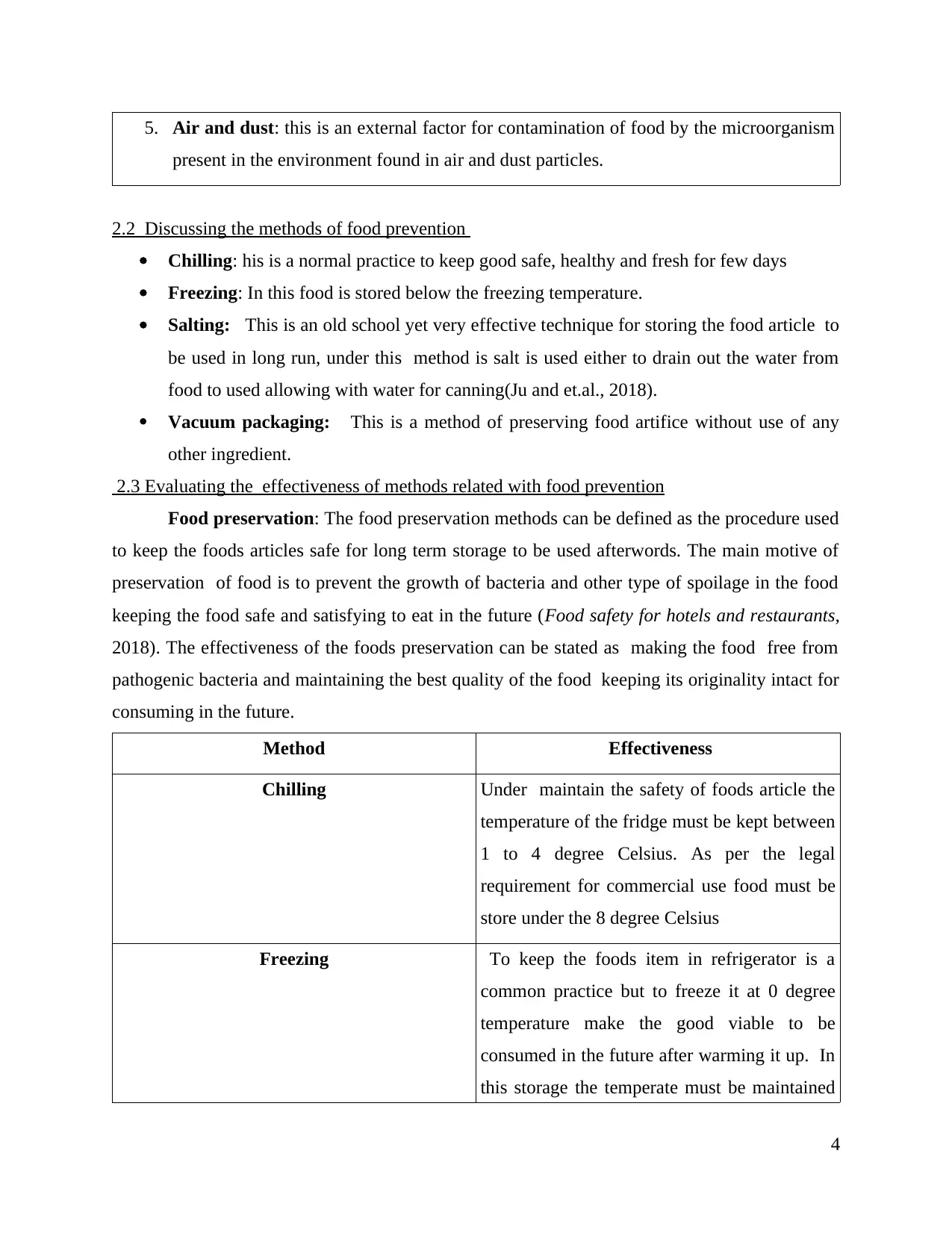
5. Air and dust: this is an external factor for contamination of food by the microorganism
present in the environment found in air and dust particles.
2.2 Discussing the methods of food prevention
Chilling: his is a normal practice to keep good safe, healthy and fresh for few days
Freezing: In this food is stored below the freezing temperature.
Salting: This is an old school yet very effective technique for storing the food article to
be used in long run, under this method is salt is used either to drain out the water from
food to used allowing with water for canning(Ju and et.al., 2018).
Vacuum packaging: This is a method of preserving food artifice without use of any
other ingredient.
2.3 Evaluating the effectiveness of methods related with food prevention
Food preservation: The food preservation methods can be defined as the procedure used
to keep the foods articles safe for long term storage to be used afterwords. The main motive of
preservation of food is to prevent the growth of bacteria and other type of spoilage in the food
keeping the food safe and satisfying to eat in the future (Food safety for hotels and restaurants,
2018). The effectiveness of the foods preservation can be stated as making the food free from
pathogenic bacteria and maintaining the best quality of the food keeping its originality intact for
consuming in the future.
Method Effectiveness
Chilling Under maintain the safety of foods article the
temperature of the fridge must be kept between
1 to 4 degree Celsius. As per the legal
requirement for commercial use food must be
store under the 8 degree Celsius
Freezing To keep the foods item in refrigerator is a
common practice but to freeze it at 0 degree
temperature make the good viable to be
consumed in the future after warming it up. In
this storage the temperate must be maintained
4
present in the environment found in air and dust particles.
2.2 Discussing the methods of food prevention
Chilling: his is a normal practice to keep good safe, healthy and fresh for few days
Freezing: In this food is stored below the freezing temperature.
Salting: This is an old school yet very effective technique for storing the food article to
be used in long run, under this method is salt is used either to drain out the water from
food to used allowing with water for canning(Ju and et.al., 2018).
Vacuum packaging: This is a method of preserving food artifice without use of any
other ingredient.
2.3 Evaluating the effectiveness of methods related with food prevention
Food preservation: The food preservation methods can be defined as the procedure used
to keep the foods articles safe for long term storage to be used afterwords. The main motive of
preservation of food is to prevent the growth of bacteria and other type of spoilage in the food
keeping the food safe and satisfying to eat in the future (Food safety for hotels and restaurants,
2018). The effectiveness of the foods preservation can be stated as making the food free from
pathogenic bacteria and maintaining the best quality of the food keeping its originality intact for
consuming in the future.
Method Effectiveness
Chilling Under maintain the safety of foods article the
temperature of the fridge must be kept between
1 to 4 degree Celsius. As per the legal
requirement for commercial use food must be
store under the 8 degree Celsius
Freezing To keep the foods item in refrigerator is a
common practice but to freeze it at 0 degree
temperature make the good viable to be
consumed in the future after warming it up. In
this storage the temperate must be maintained
4
⊘ This is a preview!⊘
Do you want full access?
Subscribe today to unlock all pages.

Trusted by 1+ million students worldwide
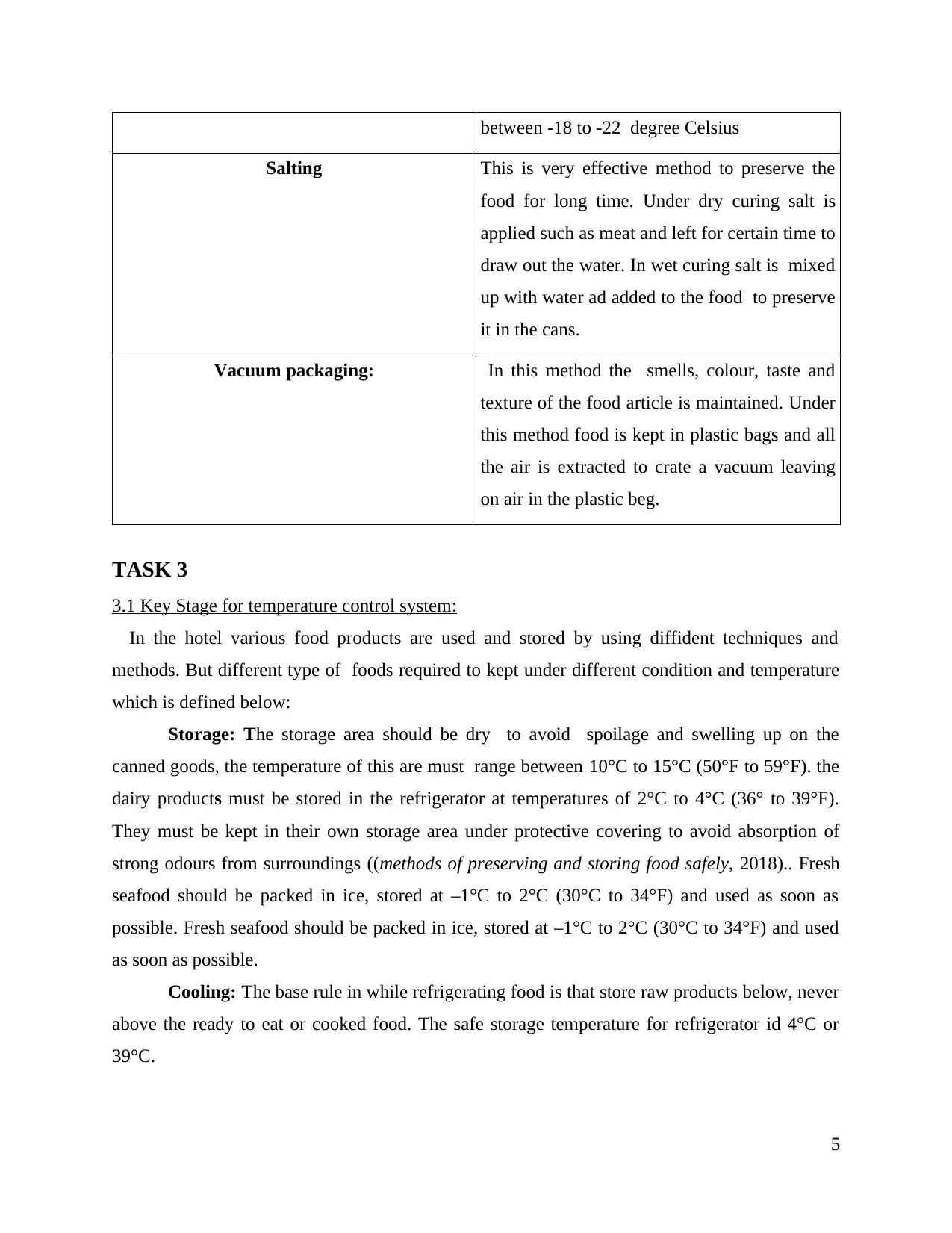
between -18 to -22 degree Celsius
Salting This is very effective method to preserve the
food for long time. Under dry curing salt is
applied such as meat and left for certain time to
draw out the water. In wet curing salt is mixed
up with water ad added to the food to preserve
it in the cans.
Vacuum packaging: In this method the smells, colour, taste and
texture of the food article is maintained. Under
this method food is kept in plastic bags and all
the air is extracted to crate a vacuum leaving
on air in the plastic beg.
TASK 3
3.1 Key Stage for temperature control system:
In the hotel various food products are used and stored by using diffident techniques and
methods. But different type of foods required to kept under different condition and temperature
which is defined below:
Storage: The storage area should be dry to avoid spoilage and swelling up on the
canned goods, the temperature of this are must range between 10°C to 15°C (50°F to 59°F). the
dairy products must be stored in the refrigerator at temperatures of 2°C to 4°C (36° to 39°F).
They must be kept in their own storage area under protective covering to avoid absorption of
strong odours from surroundings ((methods of preserving and storing food safely, 2018).. Fresh
seafood should be packed in ice, stored at –1°C to 2°C (30°C to 34°F) and used as soon as
possible. Fresh seafood should be packed in ice, stored at –1°C to 2°C (30°C to 34°F) and used
as soon as possible.
Cooling: The base rule in while refrigerating food is that store raw products below, never
above the ready to eat or cooked food. The safe storage temperature for refrigerator id 4°C or
39°C.
5
Salting This is very effective method to preserve the
food for long time. Under dry curing salt is
applied such as meat and left for certain time to
draw out the water. In wet curing salt is mixed
up with water ad added to the food to preserve
it in the cans.
Vacuum packaging: In this method the smells, colour, taste and
texture of the food article is maintained. Under
this method food is kept in plastic bags and all
the air is extracted to crate a vacuum leaving
on air in the plastic beg.
TASK 3
3.1 Key Stage for temperature control system:
In the hotel various food products are used and stored by using diffident techniques and
methods. But different type of foods required to kept under different condition and temperature
which is defined below:
Storage: The storage area should be dry to avoid spoilage and swelling up on the
canned goods, the temperature of this are must range between 10°C to 15°C (50°F to 59°F). the
dairy products must be stored in the refrigerator at temperatures of 2°C to 4°C (36° to 39°F).
They must be kept in their own storage area under protective covering to avoid absorption of
strong odours from surroundings ((methods of preserving and storing food safely, 2018).. Fresh
seafood should be packed in ice, stored at –1°C to 2°C (30°C to 34°F) and used as soon as
possible. Fresh seafood should be packed in ice, stored at –1°C to 2°C (30°C to 34°F) and used
as soon as possible.
Cooling: The base rule in while refrigerating food is that store raw products below, never
above the ready to eat or cooked food. The safe storage temperature for refrigerator id 4°C or
39°C.
5
Paraphrase This Document
Need a fresh take? Get an instant paraphrase of this document with our AI Paraphraser
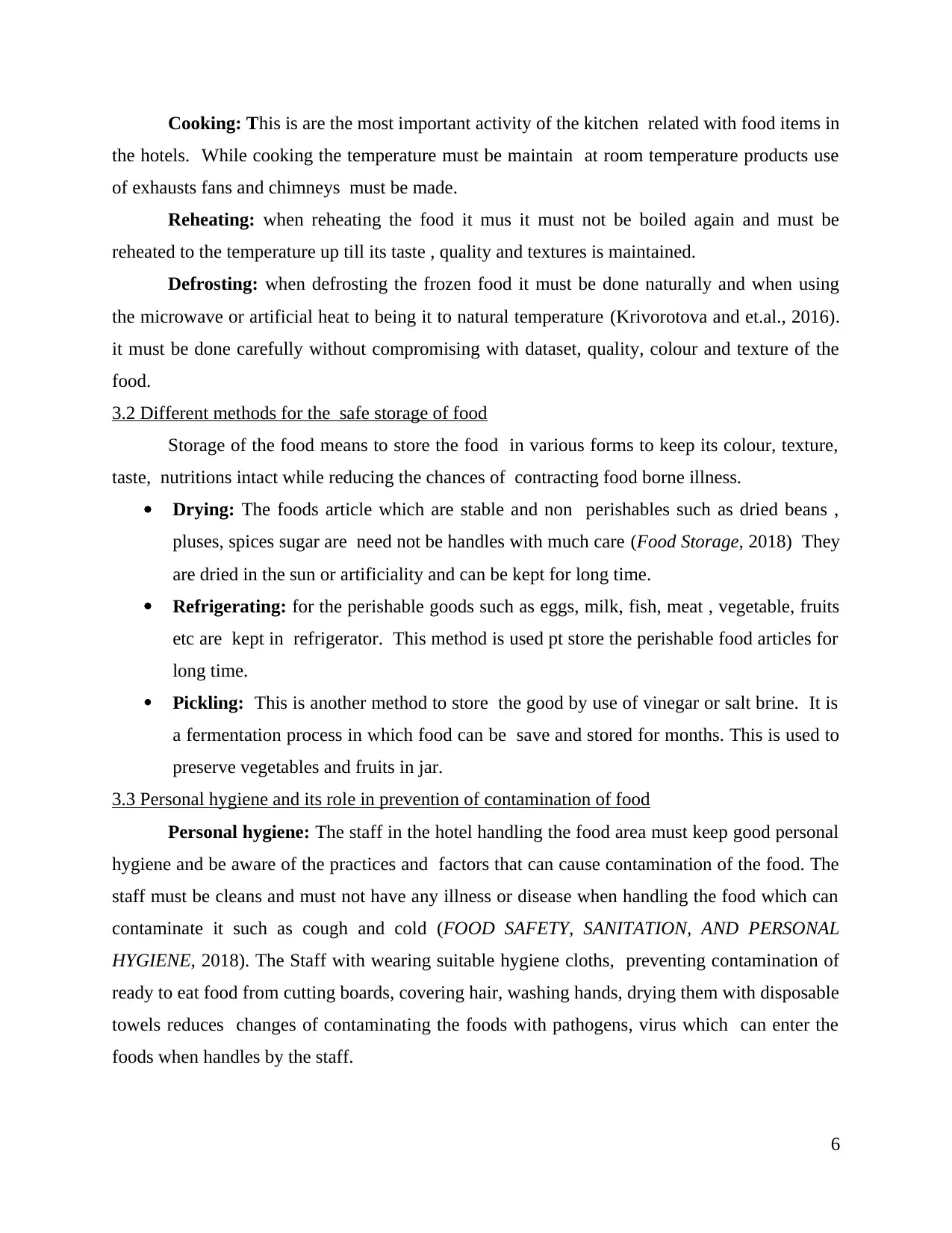
Cooking: This is are the most important activity of the kitchen related with food items in
the hotels. While cooking the temperature must be maintain at room temperature products use
of exhausts fans and chimneys must be made.
Reheating: when reheating the food it mus it must not be boiled again and must be
reheated to the temperature up till its taste , quality and textures is maintained.
Defrosting: when defrosting the frozen food it must be done naturally and when using
the microwave or artificial heat to being it to natural temperature (Krivorotova and et.al., 2016).
it must be done carefully without compromising with dataset, quality, colour and texture of the
food.
3.2 Different methods for the safe storage of food
Storage of the food means to store the food in various forms to keep its colour, texture,
taste, nutritions intact while reducing the chances of contracting food borne illness.
Drying: The foods article which are stable and non perishables such as dried beans ,
pluses, spices sugar are need not be handles with much care (Food Storage, 2018) They
are dried in the sun or artificiality and can be kept for long time.
Refrigerating: for the perishable goods such as eggs, milk, fish, meat , vegetable, fruits
etc are kept in refrigerator. This method is used pt store the perishable food articles for
long time.
Pickling: This is another method to store the good by use of vinegar or salt brine. It is
a fermentation process in which food can be save and stored for months. This is used to
preserve vegetables and fruits in jar.
3.3 Personal hygiene and its role in prevention of contamination of food
Personal hygiene: The staff in the hotel handling the food area must keep good personal
hygiene and be aware of the practices and factors that can cause contamination of the food. The
staff must be cleans and must not have any illness or disease when handling the food which can
contaminate it such as cough and cold (FOOD SAFETY, SANITATION, AND PERSONAL
HYGIENE, 2018). The Staff with wearing suitable hygiene cloths, preventing contamination of
ready to eat food from cutting boards, covering hair, washing hands, drying them with disposable
towels reduces changes of contaminating the foods with pathogens, virus which can enter the
foods when handles by the staff.
6
the hotels. While cooking the temperature must be maintain at room temperature products use
of exhausts fans and chimneys must be made.
Reheating: when reheating the food it mus it must not be boiled again and must be
reheated to the temperature up till its taste , quality and textures is maintained.
Defrosting: when defrosting the frozen food it must be done naturally and when using
the microwave or artificial heat to being it to natural temperature (Krivorotova and et.al., 2016).
it must be done carefully without compromising with dataset, quality, colour and texture of the
food.
3.2 Different methods for the safe storage of food
Storage of the food means to store the food in various forms to keep its colour, texture,
taste, nutritions intact while reducing the chances of contracting food borne illness.
Drying: The foods article which are stable and non perishables such as dried beans ,
pluses, spices sugar are need not be handles with much care (Food Storage, 2018) They
are dried in the sun or artificiality and can be kept for long time.
Refrigerating: for the perishable goods such as eggs, milk, fish, meat , vegetable, fruits
etc are kept in refrigerator. This method is used pt store the perishable food articles for
long time.
Pickling: This is another method to store the good by use of vinegar or salt brine. It is
a fermentation process in which food can be save and stored for months. This is used to
preserve vegetables and fruits in jar.
3.3 Personal hygiene and its role in prevention of contamination of food
Personal hygiene: The staff in the hotel handling the food area must keep good personal
hygiene and be aware of the practices and factors that can cause contamination of the food. The
staff must be cleans and must not have any illness or disease when handling the food which can
contaminate it such as cough and cold (FOOD SAFETY, SANITATION, AND PERSONAL
HYGIENE, 2018). The Staff with wearing suitable hygiene cloths, preventing contamination of
ready to eat food from cutting boards, covering hair, washing hands, drying them with disposable
towels reduces changes of contaminating the foods with pathogens, virus which can enter the
foods when handles by the staff.
6
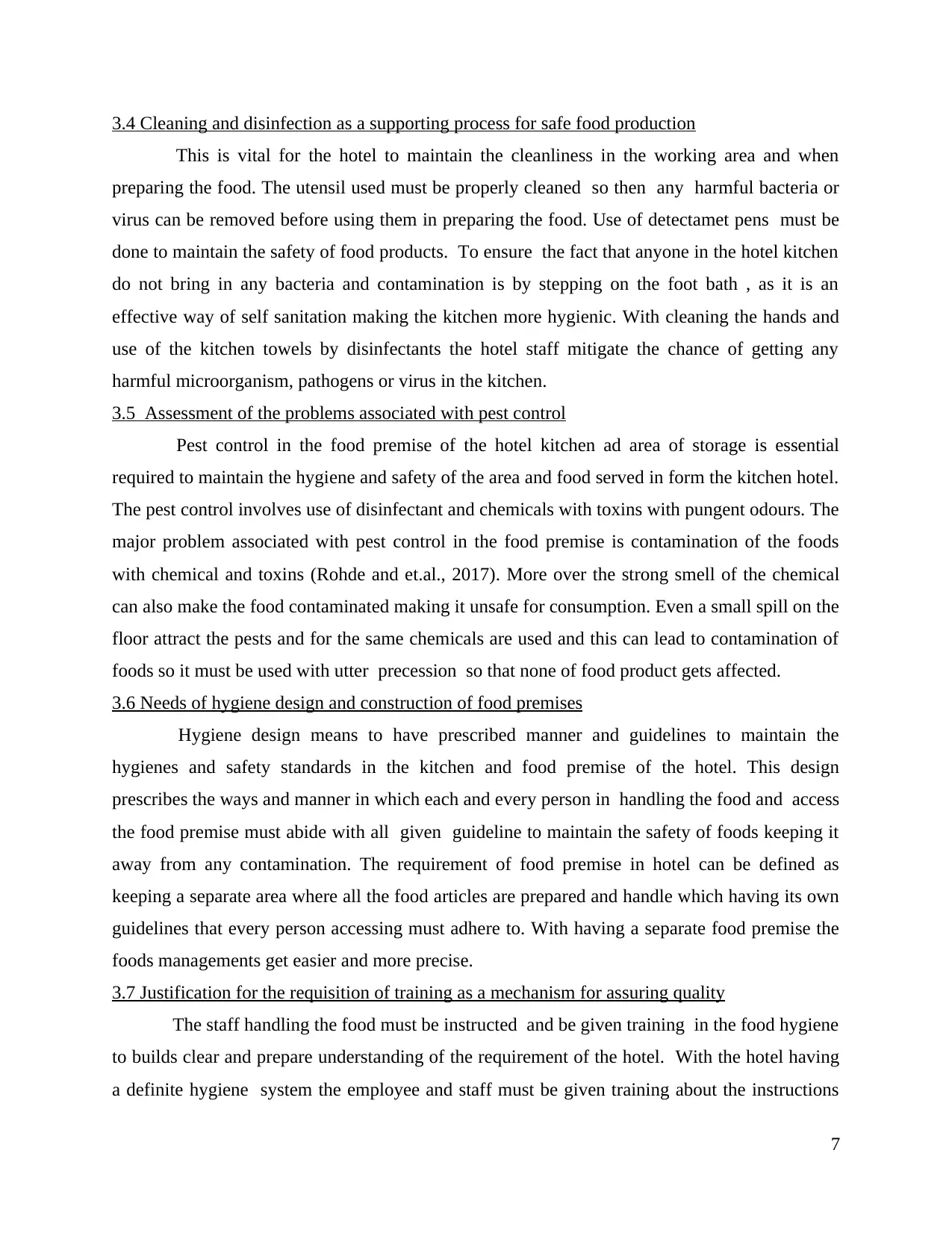
3.4 Cleaning and disinfection as a supporting process for safe food production
This is vital for the hotel to maintain the cleanliness in the working area and when
preparing the food. The utensil used must be properly cleaned so then any harmful bacteria or
virus can be removed before using them in preparing the food. Use of detectamet pens must be
done to maintain the safety of food products. To ensure the fact that anyone in the hotel kitchen
do not bring in any bacteria and contamination is by stepping on the foot bath , as it is an
effective way of self sanitation making the kitchen more hygienic. With cleaning the hands and
use of the kitchen towels by disinfectants the hotel staff mitigate the chance of getting any
harmful microorganism, pathogens or virus in the kitchen.
3.5 Assessment of the problems associated with pest control
Pest control in the food premise of the hotel kitchen ad area of storage is essential
required to maintain the hygiene and safety of the area and food served in form the kitchen hotel.
The pest control involves use of disinfectant and chemicals with toxins with pungent odours. The
major problem associated with pest control in the food premise is contamination of the foods
with chemical and toxins (Rohde and et.al., 2017). More over the strong smell of the chemical
can also make the food contaminated making it unsafe for consumption. Even a small spill on the
floor attract the pests and for the same chemicals are used and this can lead to contamination of
foods so it must be used with utter precession so that none of food product gets affected.
3.6 Needs of hygiene design and construction of food premises
Hygiene design means to have prescribed manner and guidelines to maintain the
hygienes and safety standards in the kitchen and food premise of the hotel. This design
prescribes the ways and manner in which each and every person in handling the food and access
the food premise must abide with all given guideline to maintain the safety of foods keeping it
away from any contamination. The requirement of food premise in hotel can be defined as
keeping a separate area where all the food articles are prepared and handle which having its own
guidelines that every person accessing must adhere to. With having a separate food premise the
foods managements get easier and more precise.
3.7 Justification for the requisition of training as a mechanism for assuring quality
The staff handling the food must be instructed and be given training in the food hygiene
to builds clear and prepare understanding of the requirement of the hotel. With the hotel having
a definite hygiene system the employee and staff must be given training about the instructions
7
This is vital for the hotel to maintain the cleanliness in the working area and when
preparing the food. The utensil used must be properly cleaned so then any harmful bacteria or
virus can be removed before using them in preparing the food. Use of detectamet pens must be
done to maintain the safety of food products. To ensure the fact that anyone in the hotel kitchen
do not bring in any bacteria and contamination is by stepping on the foot bath , as it is an
effective way of self sanitation making the kitchen more hygienic. With cleaning the hands and
use of the kitchen towels by disinfectants the hotel staff mitigate the chance of getting any
harmful microorganism, pathogens or virus in the kitchen.
3.5 Assessment of the problems associated with pest control
Pest control in the food premise of the hotel kitchen ad area of storage is essential
required to maintain the hygiene and safety of the area and food served in form the kitchen hotel.
The pest control involves use of disinfectant and chemicals with toxins with pungent odours. The
major problem associated with pest control in the food premise is contamination of the foods
with chemical and toxins (Rohde and et.al., 2017). More over the strong smell of the chemical
can also make the food contaminated making it unsafe for consumption. Even a small spill on the
floor attract the pests and for the same chemicals are used and this can lead to contamination of
foods so it must be used with utter precession so that none of food product gets affected.
3.6 Needs of hygiene design and construction of food premises
Hygiene design means to have prescribed manner and guidelines to maintain the
hygienes and safety standards in the kitchen and food premise of the hotel. This design
prescribes the ways and manner in which each and every person in handling the food and access
the food premise must abide with all given guideline to maintain the safety of foods keeping it
away from any contamination. The requirement of food premise in hotel can be defined as
keeping a separate area where all the food articles are prepared and handle which having its own
guidelines that every person accessing must adhere to. With having a separate food premise the
foods managements get easier and more precise.
3.7 Justification for the requisition of training as a mechanism for assuring quality
The staff handling the food must be instructed and be given training in the food hygiene
to builds clear and prepare understanding of the requirement of the hotel. With the hotel having
a definite hygiene system the employee and staff must be given training about the instructions
7
⊘ This is a preview!⊘
Do you want full access?
Subscribe today to unlock all pages.

Trusted by 1+ million students worldwide
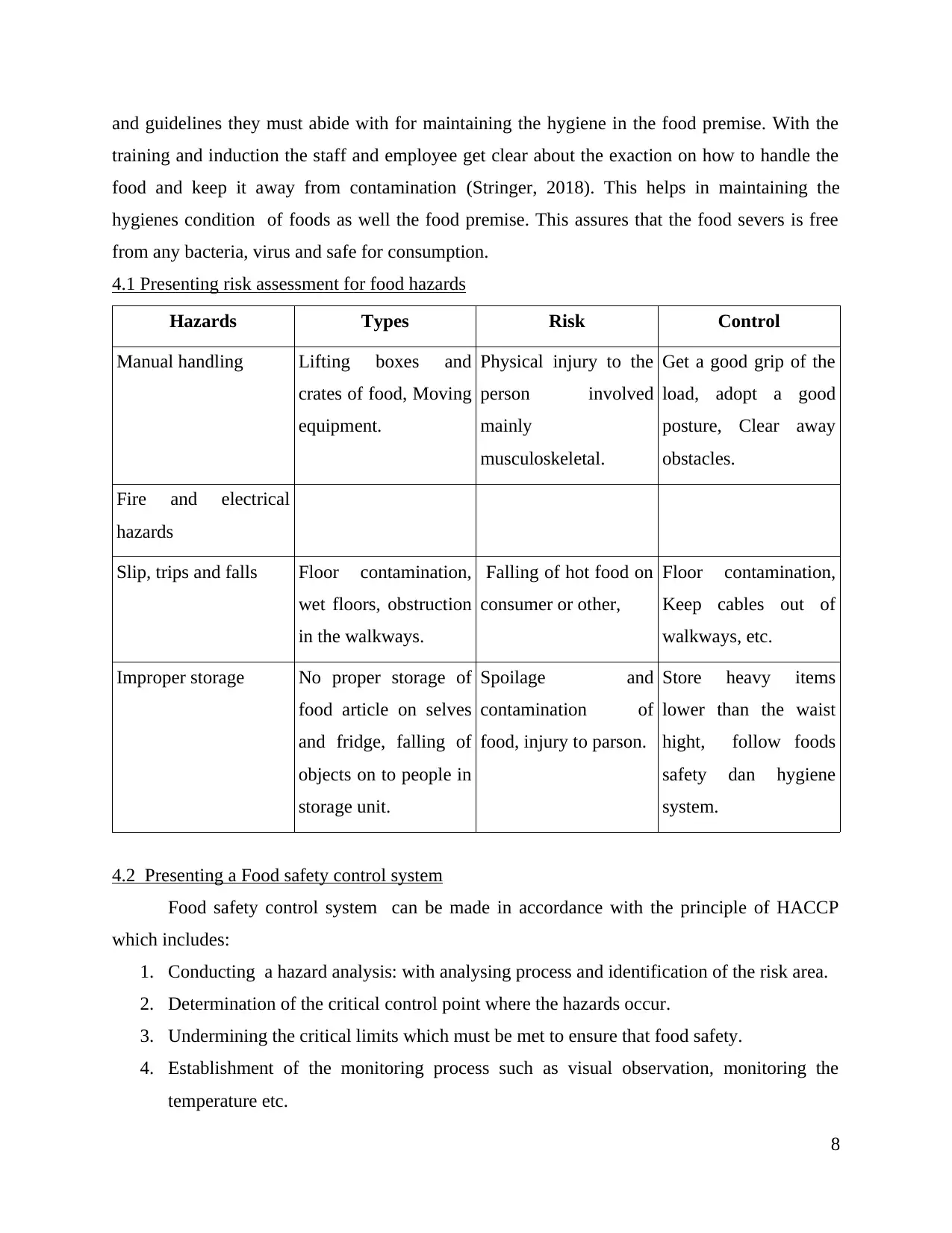
and guidelines they must abide with for maintaining the hygiene in the food premise. With the
training and induction the staff and employee get clear about the exaction on how to handle the
food and keep it away from contamination (Stringer, 2018). This helps in maintaining the
hygienes condition of foods as well the food premise. This assures that the food severs is free
from any bacteria, virus and safe for consumption.
4.1 Presenting risk assessment for food hazards
Hazards Types Risk Control
Manual handling Lifting boxes and
crates of food, Moving
equipment.
Physical injury to the
person involved
mainly
musculoskeletal.
Get a good grip of the
load, adopt a good
posture, Clear away
obstacles.
Fire and electrical
hazards
Slip, trips and falls Floor contamination,
wet floors, obstruction
in the walkways.
Falling of hot food on
consumer or other,
Floor contamination,
Keep cables out of
walkways, etc.
Improper storage No proper storage of
food article on selves
and fridge, falling of
objects on to people in
storage unit.
Spoilage and
contamination of
food, injury to parson.
Store heavy items
lower than the waist
hight, follow foods
safety dan hygiene
system.
4.2 Presenting a Food safety control system
Food safety control system can be made in accordance with the principle of HACCP
which includes:
1. Conducting a hazard analysis: with analysing process and identification of the risk area.
2. Determination of the critical control point where the hazards occur.
3. Undermining the critical limits which must be met to ensure that food safety.
4. Establishment of the monitoring process such as visual observation, monitoring the
temperature etc.
8
training and induction the staff and employee get clear about the exaction on how to handle the
food and keep it away from contamination (Stringer, 2018). This helps in maintaining the
hygienes condition of foods as well the food premise. This assures that the food severs is free
from any bacteria, virus and safe for consumption.
4.1 Presenting risk assessment for food hazards
Hazards Types Risk Control
Manual handling Lifting boxes and
crates of food, Moving
equipment.
Physical injury to the
person involved
mainly
musculoskeletal.
Get a good grip of the
load, adopt a good
posture, Clear away
obstacles.
Fire and electrical
hazards
Slip, trips and falls Floor contamination,
wet floors, obstruction
in the walkways.
Falling of hot food on
consumer or other,
Floor contamination,
Keep cables out of
walkways, etc.
Improper storage No proper storage of
food article on selves
and fridge, falling of
objects on to people in
storage unit.
Spoilage and
contamination of
food, injury to parson.
Store heavy items
lower than the waist
hight, follow foods
safety dan hygiene
system.
4.2 Presenting a Food safety control system
Food safety control system can be made in accordance with the principle of HACCP
which includes:
1. Conducting a hazard analysis: with analysing process and identification of the risk area.
2. Determination of the critical control point where the hazards occur.
3. Undermining the critical limits which must be met to ensure that food safety.
4. Establishment of the monitoring process such as visual observation, monitoring the
temperature etc.
8
Paraphrase This Document
Need a fresh take? Get an instant paraphrase of this document with our AI Paraphraser
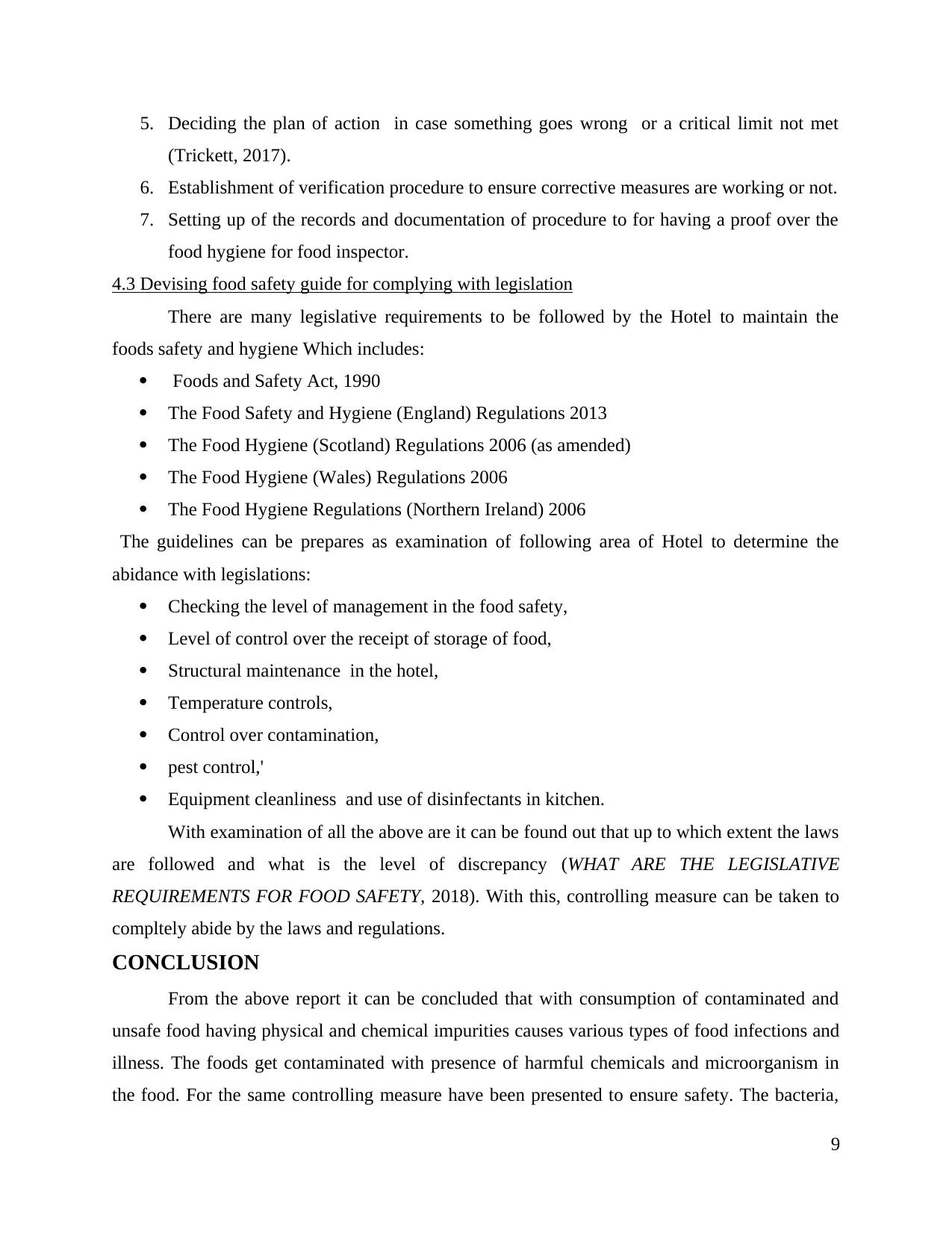
5. Deciding the plan of action in case something goes wrong or a critical limit not met
(Trickett, 2017).
6. Establishment of verification procedure to ensure corrective measures are working or not.
7. Setting up of the records and documentation of procedure to for having a proof over the
food hygiene for food inspector.
4.3 Devising food safety guide for complying with legislation
There are many legislative requirements to be followed by the Hotel to maintain the
foods safety and hygiene Which includes:
Foods and Safety Act, 1990
The Food Safety and Hygiene (England) Regulations 2013
The Food Hygiene (Scotland) Regulations 2006 (as amended)
The Food Hygiene (Wales) Regulations 2006
The Food Hygiene Regulations (Northern Ireland) 2006
The guidelines can be prepares as examination of following area of Hotel to determine the
abidance with legislations:
Checking the level of management in the food safety,
Level of control over the receipt of storage of food,
Structural maintenance in the hotel,
Temperature controls,
Control over contamination,
pest control,'
Equipment cleanliness and use of disinfectants in kitchen.
With examination of all the above are it can be found out that up to which extent the laws
are followed and what is the level of discrepancy (WHAT ARE THE LEGISLATIVE
REQUIREMENTS FOR FOOD SAFETY, 2018). With this, controlling measure can be taken to
compltely abide by the laws and regulations.
CONCLUSION
From the above report it can be concluded that with consumption of contaminated and
unsafe food having physical and chemical impurities causes various types of food infections and
illness. The foods get contaminated with presence of harmful chemicals and microorganism in
the food. For the same controlling measure have been presented to ensure safety. The bacteria,
9
(Trickett, 2017).
6. Establishment of verification procedure to ensure corrective measures are working or not.
7. Setting up of the records and documentation of procedure to for having a proof over the
food hygiene for food inspector.
4.3 Devising food safety guide for complying with legislation
There are many legislative requirements to be followed by the Hotel to maintain the
foods safety and hygiene Which includes:
Foods and Safety Act, 1990
The Food Safety and Hygiene (England) Regulations 2013
The Food Hygiene (Scotland) Regulations 2006 (as amended)
The Food Hygiene (Wales) Regulations 2006
The Food Hygiene Regulations (Northern Ireland) 2006
The guidelines can be prepares as examination of following area of Hotel to determine the
abidance with legislations:
Checking the level of management in the food safety,
Level of control over the receipt of storage of food,
Structural maintenance in the hotel,
Temperature controls,
Control over contamination,
pest control,'
Equipment cleanliness and use of disinfectants in kitchen.
With examination of all the above are it can be found out that up to which extent the laws
are followed and what is the level of discrepancy (WHAT ARE THE LEGISLATIVE
REQUIREMENTS FOR FOOD SAFETY, 2018). With this, controlling measure can be taken to
compltely abide by the laws and regulations.
CONCLUSION
From the above report it can be concluded that with consumption of contaminated and
unsafe food having physical and chemical impurities causes various types of food infections and
illness. The foods get contaminated with presence of harmful chemicals and microorganism in
the food. For the same controlling measure have been presented to ensure safety. The bacteria,
9
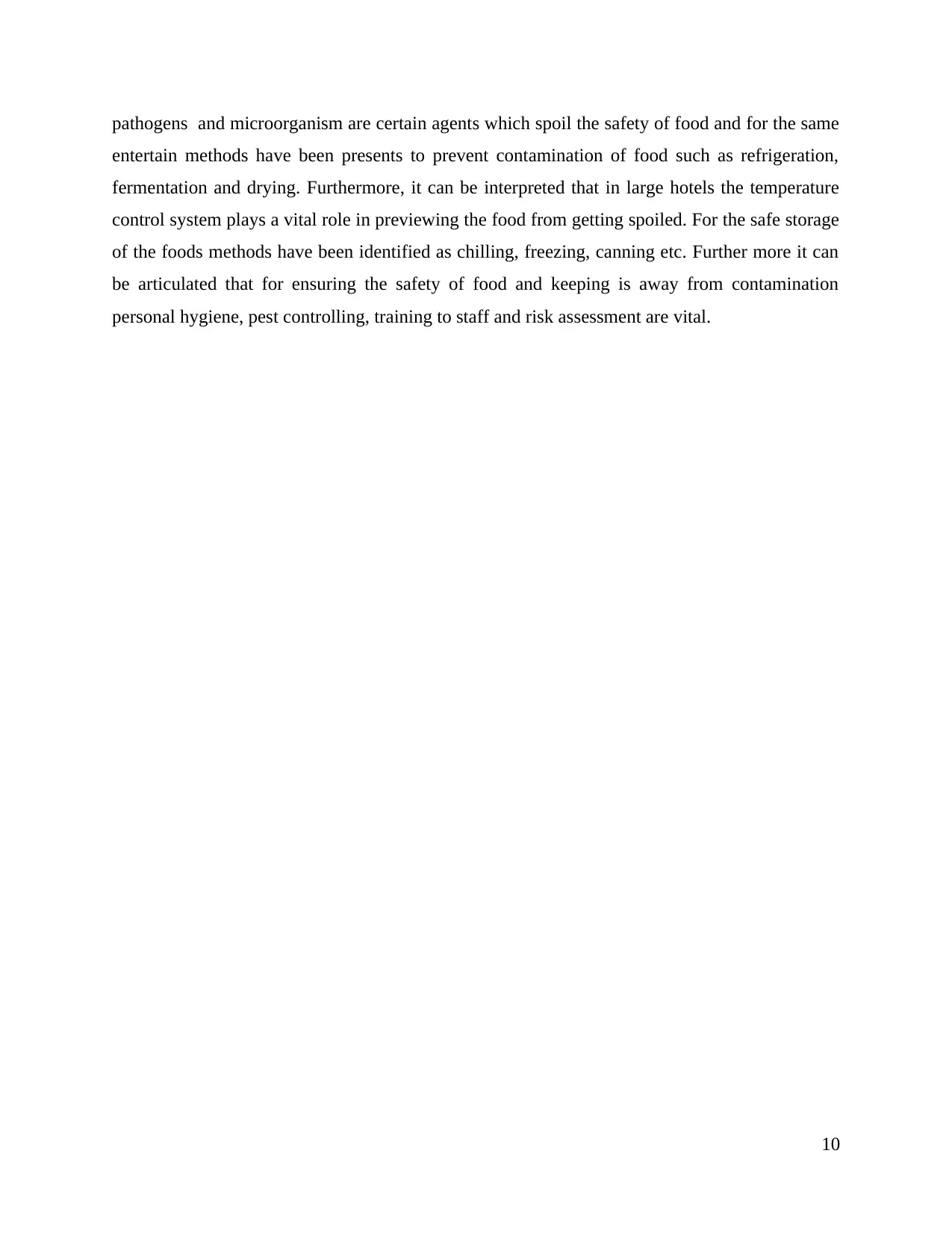
pathogens and microorganism are certain agents which spoil the safety of food and for the same
entertain methods have been presents to prevent contamination of food such as refrigeration,
fermentation and drying. Furthermore, it can be interpreted that in large hotels the temperature
control system plays a vital role in previewing the food from getting spoiled. For the safe storage
of the foods methods have been identified as chilling, freezing, canning etc. Further more it can
be articulated that for ensuring the safety of food and keeping is away from contamination
personal hygiene, pest controlling, training to staff and risk assessment are vital.
10
entertain methods have been presents to prevent contamination of food such as refrigeration,
fermentation and drying. Furthermore, it can be interpreted that in large hotels the temperature
control system plays a vital role in previewing the food from getting spoiled. For the safe storage
of the foods methods have been identified as chilling, freezing, canning etc. Further more it can
be articulated that for ensuring the safety of food and keeping is away from contamination
personal hygiene, pest controlling, training to staff and risk assessment are vital.
10
⊘ This is a preview!⊘
Do you want full access?
Subscribe today to unlock all pages.

Trusted by 1+ million students worldwide
1 out of 15
Related Documents
Your All-in-One AI-Powered Toolkit for Academic Success.
+13062052269
info@desklib.com
Available 24*7 on WhatsApp / Email
![[object Object]](/_next/static/media/star-bottom.7253800d.svg)
Unlock your academic potential
Copyright © 2020–2025 A2Z Services. All Rights Reserved. Developed and managed by ZUCOL.





